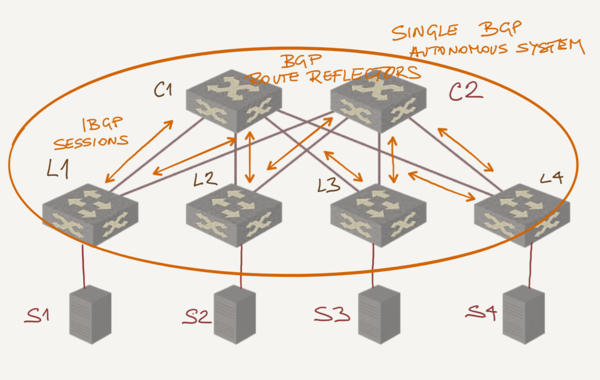Building Next-Generation Data Center
Using BGP in a Data Center Leaf-and-Spine Fabric
ipSpace.net » Documents » Using BGP in a Data Center Leaf-and-Spine Fabric
Large data center leaf-and-spine fabrics often use BGP to propagate endpoint reachability information (using IPv4, IPv6 or EVPN address family), or to replace IGP.
In both cases, you have to decide whether to use IBGP or EBGP within the fabric, and whether to use one or multiple AS numbers on the leaf layer and the spine layer.
This document covers the following design decisions:
- Should we use BGP as a routing protocol within a data center fabric?
- Should we use IBGP or EBGP within the leaf-and-spine fabric?
- Should we use the same AS number on all spine switches?
- Should we use the same AS number on all leaf switches, or should each leaf switch have a unique AS number?
- Should leaf switches in an MLAG cluster use the same AS number, or should they have a unique AS number?
- What’s the impact of AS numbering on EVPN and MPLS/VPN services?
Before You Start
The rest of the document assumes reasonable familiarity with BGP concepts (for example, the details of next-hop handling in BGP or the difference between IBGP and EBGP).
If you’re building a small data center fabric no larger than a few dozen switches, and are not familiar with BGP use these rules-of-thumb while keeping in mind you should understand recipes you use:
- Use OSPF or IS-IS as the fabric routing protocol.
- Use BGP only when needed, for example to run EVPN control plane.
When you plan to run BGP in combination with an underlying IGP:
- Use IBGP within a single data center (or pod) and EBGP between them
- Use spine switches as BGP route reflectors.
More information
- Explore related webinars, podcasts an blog posts;
- Watch Leaf-and-Spine Fabric Architectures to learn more about using routing protocols in data center fabrics;
- Want to master data center technologies and architectures, including compute, storage, and network services? Check out the Building Next-Generation Data Center online course.
Table of Contents
- Introduction
- BGP as a Data Center Fabric Routing Protocol
- Autonomous Systems and AS Numbers
- BGP in EVPN-Based Data Center Fabrics
- EVPN Route Target Considerations
Upcoming
- Performance Impact of Running EVPN over EBGP Sessions
- Impact of MPLS/VPN

